The Ross Dependency is such a unique and dramatic environment and is home to a variety of interesting bird species.
Issue information
The Antarctic Continent is surrounded by the powerful Southern Ocean. Cold, huge, rich with food and famous for its sheer ferocity, this ocean is also home to enormous numbers of remarkable sea-birds. These birds fly over vast tracts of iceberg-choked water in search of plankton and tiny fish.
Six Antarctic sea birds that were depicted on this Ross Dependency stamp issue. Mostly white on the underbody but with a variety of distinctive upper body colourings ranging from pearly grey and bluish black to dark brown and pale blue, these birds were shown in their natural habitat.
Four of the stamps depicting the Snow Petrel, Cape Petrel, Antarctic Fulmer and Antarctic Petrel included the World Wide Fund For Nature logo.
Se-tenant Block
The se-tenant block featured the six 1997 Ross Dependency - Antarctic Seabirds stamps without the World Wildlife Fund for Nature logo.
Ross Dependency Postage in New Zealand
Ross Dependency stamps are not valid for postage in New Zealand. Click here to find out more.
Product Listing for 1997 Ross Dependency - Antarctic Sea Birds
| Image | Title | Description | Price |
|---|---|---|---|
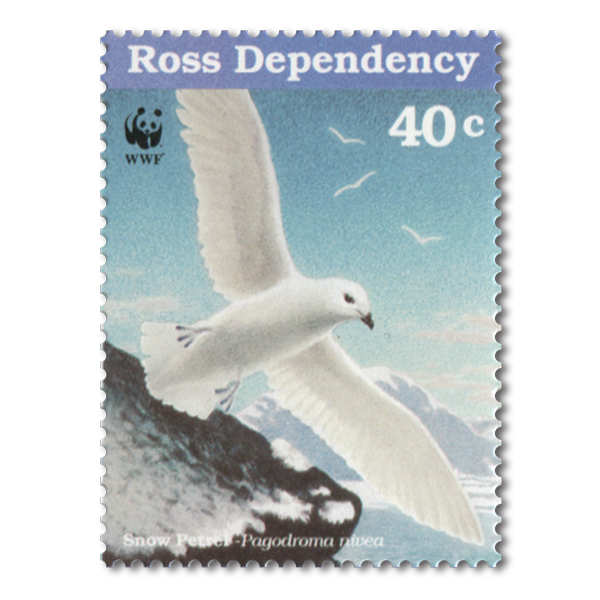 |
Single Stamp |
Single 40c 'Snow Petrel (Pagodroma nivea)' gummed stamps. Creamy white plummage and shiny coal-black dark eyes, make the snow petrel one of the most beautiful and distinctive of Antarctic sea birds. They normally live on the pack ice zone around the continent, and can often be seen resting on ice floes or grouped together on top of icebergs. Their diet consists mainly of krill and small fish that they catch while still on the wing. |
$0.40 |
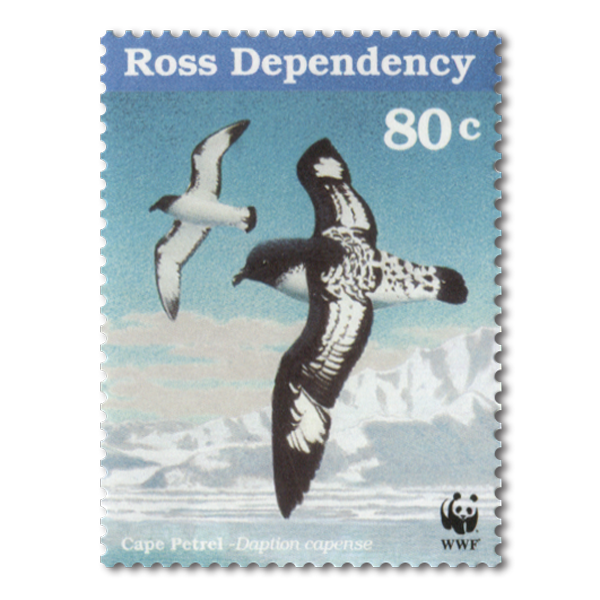 |
Single Stamp |
Single 80c 'Cape Petrel (Daption capensis)' gummed stamp. With its sooty-black head and chequered wing plumage, the cape petrel or cape pigeon as it is more commonly known, is among the most easily identified Antarctic sea birds. This is one of the larger species of sea birds that inhabit the open sub-Antarctic and Antarctic oceans. Cape Petrels often gather in noisy large flocks to feed at sea on fish, krill and squid. |
$0.80 |
 |
Single Stamp |
Single $1.00 'Antarctic Prion (Pachyptila desolata)' gummed stamp. The slender and finely marked Antarctic prion is a small bird of the region with a characteristic black "M" marking across its wings and lower back. Their underside is completely white. They are often seen in vast flocks flying extremely quickly and low over the wave tops. They breed in vast flocks between December and March and will migrate to warmer waters during winter. |
$1.00 |
 |
Single Stamp |
Single $1.20 'Antarctic Fulmar (Fulmarus glacialoides)' gummed stamp. The largest of the sea birds featured in this set of stamps, the Antarctic or southern fulmar is a graceful and powerful flier. Antarctic fulmars surface feed or make occasional shallow dives to seize krill, squid or fish. To defend their nest sites, they squirt the liquid contents of their stomachs at intruders. |
$1.20 |
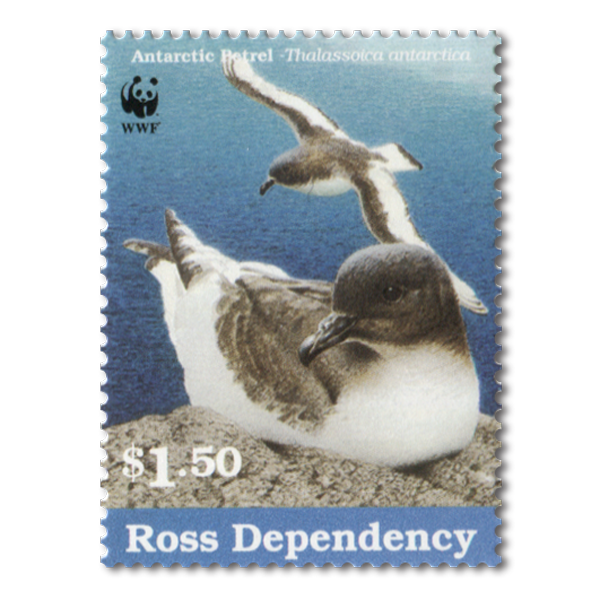 |
Single Stamp |
Single $1.50 'Antactic Petrel (Thalassoica antarctica)' gummed stamp. Slightly larger than the pigeon-sized cape petrel, the Antarctic petrel is perhaps the most numerous of the petrel species. The birds are found near the coast in vast breeding colonies of up to half a million breeding pairs. Both male and female have the same distinctive plumage - a chocolate brown head, neck and back, with a white bar on the flight feathers. |
$1.50 |
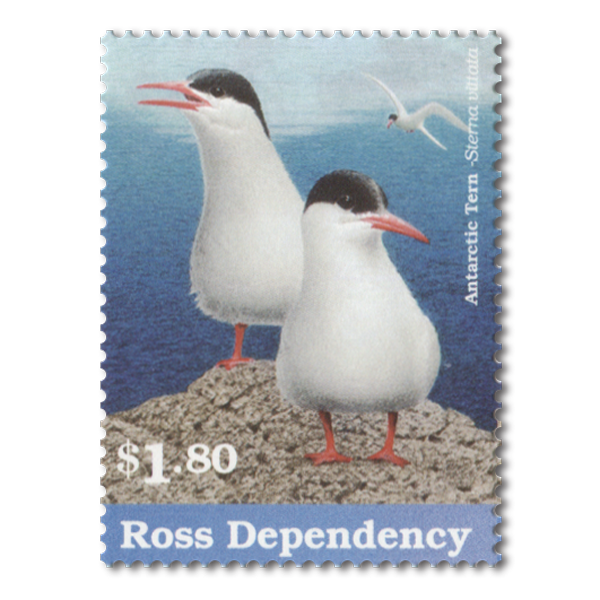 |
Single Stamp |
Single $1.80 'Antarctic Tern (Sterna vittata)' gummed stamp. A bright red bill and legs, angular wings and a forked tail make this gregarious species one of the most unusual Antarctic sea birds. A remarkable flier, the Antarctic tern is often sighted as far north as South America and South Africa. Antarctic terns live on fish and krill that they catch on the surface or by diving into the ocean. |
$1.80 |
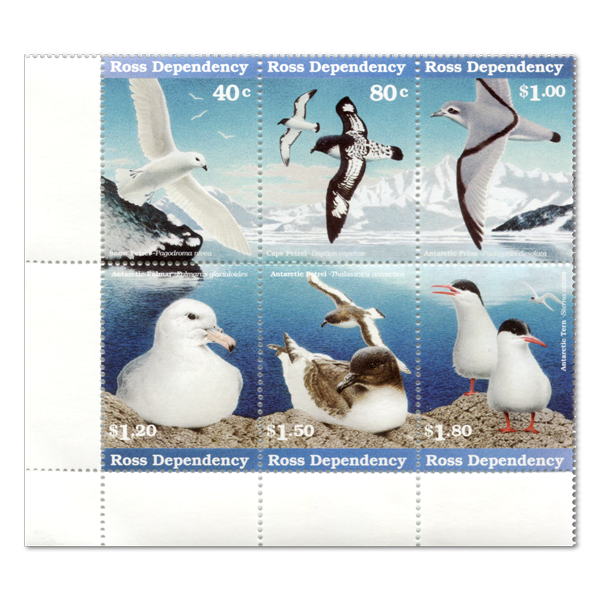 |
Se-tenant Set | Mint, used or cancelled se-tenant set. | $6.70 |
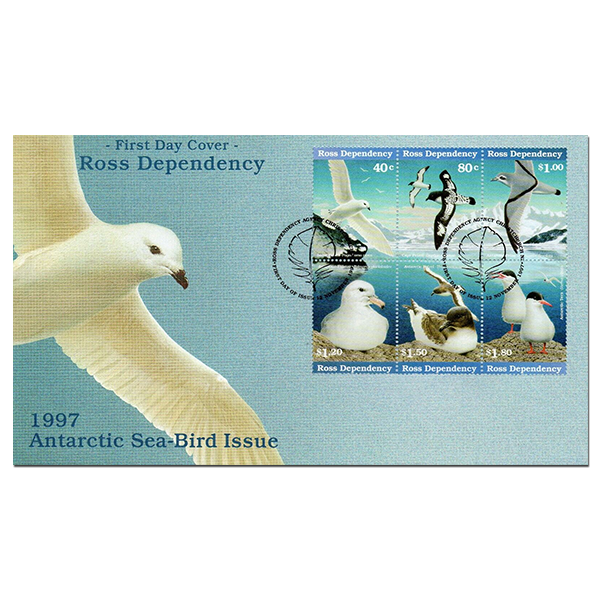 |
First Day Cover | First day cover with se-tenant set affixed. Cancelled on the first day of issue. | $7.20 |
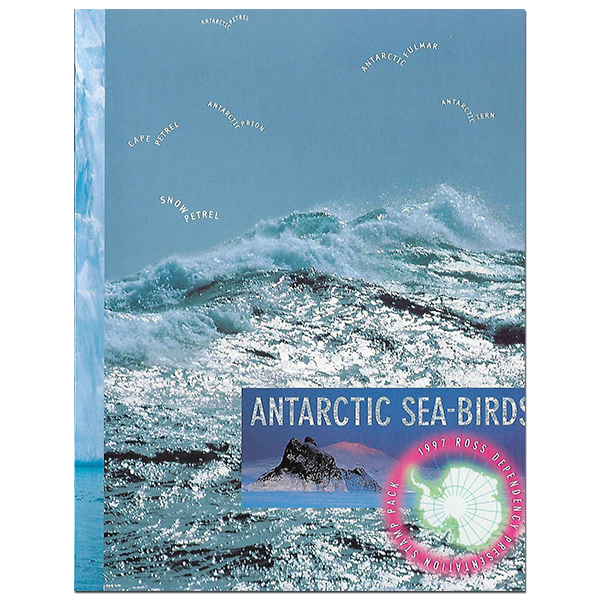 |
Presentation Pack | Presentation pack containing a selection of stamp products from the issue and further information on the theme of the stamps. | $8.50 |
Technical information
| Date of issue: | 12 November 1997 |
|---|---|
| Number of stamps: | Six |
| Denominations and designs: | 40c Snow Petrel, 80c Cape Petrel, $1.00 Antarctic Prion, $1.20 Antarctic Fulmar, $1.50 Antarctic Petrel, $1.80 Antarctic Tern |
| Stamps and first day cover designed by: | Paul Martinson, Masterton, New Zealand |
| Printer and process: | Southern Colour Print, New Zealand by lithography |
| Number of colours: | Four |
| Stamp size and format: | 30mm x 40mm (vertical) |
| Paper type: | 103gsm red phosphor coated stamp paper, unwatermarked |
| Number of stamps per sheet: | 50 |
| Perforation gauge: | 14 |
| Cost of unadressed first day cover with se-tenant block: | $7.20 |
| Special blocks: | Plate/imprint, positional or value blocks could be obtained by purchasing at least six sheet stamps. There were no marginal inscriptions for the se-tenant block of six stamps. |
| Colour blocks: | Also known as 'traffic lights', these blocks were included in plate blocks of sheet stamps. |
| Barcode blocks: | Barcode blocks were available for sheet stamps only, in both A and B formats. Barcode blocks were not available for the se-tenant block. |
| Period of sale: | These stamps remained on sale until 17 November 1998. |


